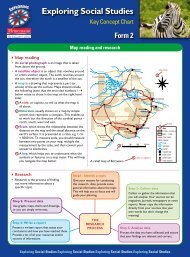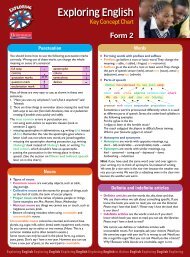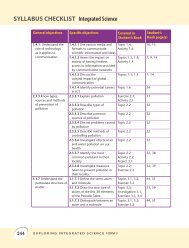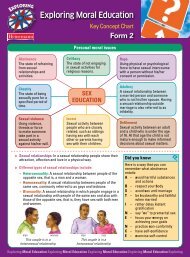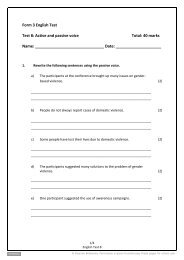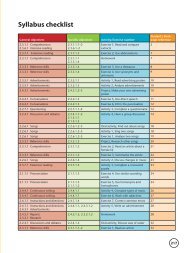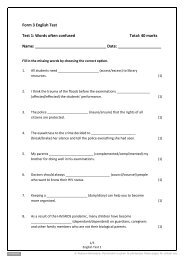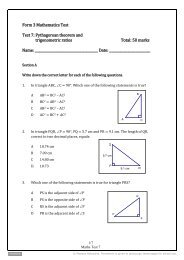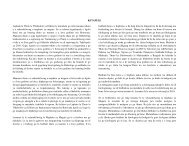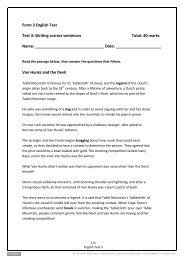- Page 8:
IntroductionThis Teacher’s Guide
- Page 14:
Extension Activity 1.1 (Student’s
- Page 18: Activity 1.3 (Student’s Book page
- Page 24: 2c h a p t e rPatterns and sequence
- Page 28: Exercise 2.3 (Student’s Book page
- Page 32: Extension Activity 2.3 (Student’s
- Page 36: Homework Exercise (Student’s Book
- Page 40: d) 4 200 3 0.945 t < 1 000∴ t > 2
- Page 44: 3. Gaborone: P 5 1.86 3 10 5 3 (1 1
- Page 56: multiply by 1.3 and then by 0.7, bu
- Page 60: 6. A 5 P1 500 000(1 1 0.089) 35 P1
- Page 64: c h a p t e r5 MatricesSyllabus: Ge
- Page 70: 3. 3 3 4;(88 268 245 16225 2130 250
- Page 76: d)( .2 .4 .6
- Page 80: 6r e t p a h c TrianglesSyllabus: G
- Page 84: Extension Activity 6.1 (Student’s
- Page 88: Support Activity 6.4 (Student’s B
- Page 92: 7c h a p t e rThe Pythagoreantheore
- Page 96: Exercise 7.2 (Student’s Book page
- Page 100: Exercise 8.1 (Student’s Book page
- Page 104: 2. tan θ 5 1__ , where θ is
- Page 108: ) AB 5 17.1 units; AC 5 12 units;BC
- Page 112: 1.Activity 9.3 (Student’s Book pa
- Page 116: 10c h a p t e rPlans, elevations an
- Page 120:
e)planf)frontsideplanfrontsideActiv
- Page 124:
Activity 10.6 (Student’s Book pag
- Page 128:
)planfrontsidec)planfront and side5
- Page 132:
Exercise 11.2 (Student’s Book pag
- Page 136:
∴ 3x 2 2 12x 5 0✓∴ 3x(x 2 4)
- Page 140:
Exercise 12.1 (Student’s Book pag
- Page 144:
Exercise 12.2 (Student’s Book pag
- Page 148:
Extension Activity 12.3 (Student’
- Page 152:
Note: It can be pointed out to stud
- Page 156:
2. a) V a5 3 10 2 3 30 5 9 424.8 c
- Page 160:
Activity 13.2 (Student’s Book pag
- Page 164:
165. a) ___49 and ____ 6434
- Page 168:
Activity 14.1 (Student’s Book pag
- Page 172:
3.f) Object stopped and turned back
- Page 176:
Project (Student’s Book page 257)
- Page 180:
3. Speed 5 ________ distancetime
- Page 184:
c)d) 0 metrese) 60 metresf) Speed 5
- Page 188:
2. a) x 2 1 5x 1 6b) 23x 2 1 3c) 22
- Page 192:
2. _______ 3a 1 4b ab2xy 2 x3
- Page 196:
Activity 15.5 (Student’s Book pag
- Page 200:
f) 2x(4x 2 1 4x 1 1)5 8x 3 1 8x 2 1
- Page 204:
Homework Activity (Student’s Book
- Page 208:
6. a) A 5 6x m 2288b) ____ 5 24
- Page 212:
Question 44.1 8x 3 1 64y 3 (3)4.2
- Page 216:
7. j 5 258. w 5 7__4 9. n 5
- Page 220:
∴ (x 2 30)(x 1 7) 5 0∴ x 5 30 m
- Page 224:
4. 1__ (2 1 x)x 5 242∴ x 2
- Page 228:
Activity 18.1 (Student’s Book pag
- Page 232:
Extension Activity 18.2 (Student’
- Page 236:
6. 5.75 3 100 5 575 bacteria7. T 2
- Page 240:
19r e t p a h c Processing data and
- Page 244:
4. a) Age last birthday Frequency A
- Page 248:
2. a) 200b) 31-40 years was the mos
- Page 252:
35Marks scored in a Mathematics tes
- Page 256:
c) Cumulative frequency of time of
- Page 260:
c) About 1 800 studentsd) Out of 2
- Page 264:
iii) Mass in kg Frequency Middle va
- Page 268:
Exercise 20.3 (Student’s Book pag
- Page 272:
21c h a p t e rScatter graphsSyllab
- Page 276:
Exercise 21.2 (Student’s Book pag
- Page 280:
2. a) Water used against average gr
- Page 284:
Exercise 22.1 (Student’s Book pag
- Page 288:
3. a)0.50.5HTH0.5TH0.50.5T0.50.50.5
- Page 292:
23c h a p t e rResearch skills: Dat
- Page 296:
Assessment 4Question 11.1 a) Two wi
- Page 300:
OR üüü (3)b) ___ 212 = 1
- Page 304:
Sample Examination Paper 2 Answers:
- Page 308:
Question 1111.1 Figure L is the ref
- Page 312:
18.1 x 22 21 0 1 2x 2 4 1ü 0ü 1 4
- Page 316:
Question 2121.1 ü (1)21.2 132 rpm





